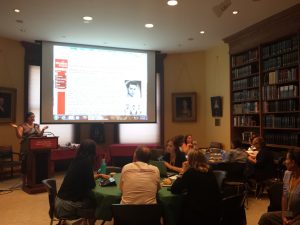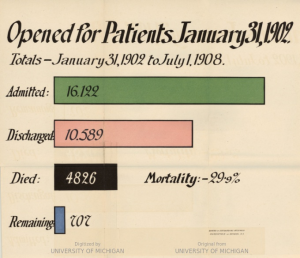~This post courtesy Anna J. Clutterbuck-Cook, Reference Librarian, Massachusetts Historical Society.
Each summer, the Massachusetts Historical Society’s Center for Teaching History hosts a series of workshops for K-12 teachers seeking to incorporate primary sources and contemporary historical scholarship into their curriculum. For the first time this year, the Center offered a three-day workshop in teaching LGBT History. As one of the Society’s reference librarians, with some background in history of sexuality research, I volunteered to spend a morning with the group sharing topic-specific research strategies. In addition to talking about the Society’s own catalog and collections, we discussed the challenges of historically-specific terminology. I introduced them to the Homosaurus, a controlled vocabulary of terms related to lesbian, gay, bisexual, and transgender lives, and we talked about the genres of material that might contain information about human sexuality: personal and family papers, visual materials, legal records, religious tracts, and medical literature.
After my presentation and a tour of the Society’s library, showcasing our own collections, the final third of the morning was spent on a research exercise in which I invited the sixteen workshop participants to search three different access tools: the Massachusetts Historical Society’s online catalog, the Digital Transgender Archive, and finally the Medical Heritage Library’s collections via the MHL’s full text search tool. My instructions were to
- Think of a research question or topic related to the history of sexuality.
- Brainstorm a handful of search terms (up to a dozen) related to your topic.
- Use these search terms in each of the three access tools.
To take the example search I performed for the group as a whole, we began with the question, “How did teenagers learn/think about sex in the 19th century?” Then, we brainstormed possible search terms, including:
- Sex education
- Teenager
- Adolescent
- Puberty
- Family life
- Marriage preparation
- Premarital sex
Then, we performed a search in each of the three search tools listed above: the MHS catalog, the Digital Transgender Archive, and the Medical Heritage Library’s full-text search. For the Medical Heritage Library’s full-text search, we began with a broad search for “sex education” in literature published between 1800 and 1900. Because the MHL provides a full-text search, however preliminary, the search results were much different from the results in the DTA and MHS catalog and prompted fruitful conversation about how both the content of a collection and its access tools shape our approaches to finding materials.
The goal of this exercise was to prompt our workshop participants to think about how different types of tools produce different search results depending upon the controlled vocabularies used, the contents of the archive, and the type of search being conducted. These questions may seem basic to archivists and librarians who spend their workdays developing and using different types of search tools, but for many of our participants the discussion of historical terms and controlled vocabularies prompted them to think in entirely new ways about how to locate materials related to the history of sexuality in archival repositories and digital collections.
The Center for Teaching History plans to run this workshop again next summer and I look forward to expanding on this exercise, hopefully giving our participants a chance to delve into the actual items their searches uncover.







